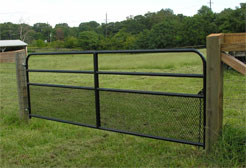|
Plan of Action for Pasture Management
 |
|
Without a
proper pasture management plan, weeds and poisonous plants
may overtake
nutritious pasture grasses.
|
The plan of action for pasture management is based on an integrated crop
management (ICM) approach to crop production. ICM is a management
approach that establishes a diverse and comprehensive system to manage
pastures on a field by field basis. A farm manager that adopts an ICM
program to maintain pastures and crops utilizes nutrients as needed to
maximize productivity; manages weeds, diseases, and insects in an
environmental and economically responsible way; and adopts the best
cultural, physical and chemical practices to enhance crop production.
An integrated crop
management program designed to maintain productive pastures would
include:
-
Site-specific soil tests to determine nutrient
levels, allowing for customized fertilization plans.
-
A rotational grazing plan, designed to enhance
the growth of forage species.
-
A flexible pasture rotation program to
accommodate fluctuating horse populations and herd composition.
-
The use of stress lots or sacrifice areas to
accommodate fluctuating environmental and forage conditions.
 |
|
A good
pasture management plan includes the use of fertilizer when
needed and
judicious use of herbicides.
|
-
Continual monitoring of forage species and
plant density to determine the need for renovation.
-
Development of a plan to overseed pastures to
thicken existing stands and add new varieties when needed.
-
Continual monitoring and identification of
weeds.
-
Adoption of a weed management program which
includes mowing, increasing forage productivity to compete with
weeds, and proper chemical control when necessary.
-
Development of a comprehensive nutrient
management plan (CMNP) in order to determine site-specific
recommendations for manure storage, composting, and spreading.
New Perimeter Fence
 |
|
A section
of the new fence at Ryders Lane. Click to enlarge.
|
Around the perimeter of the pastures at the Ryders Lane facility we have recently completed construction
of the diamond mesh fencing. This particular fencing is our preferred perimeter fence for a few reasons:
- The mesh in the fence is small enough to prevent horses’ hooves from getting through, thus preventing injury.
- The mesh can be purchased in a few different heights. At our facility we have both 4-foot and 5-foot heights. This gives the farm an option to extend the mesh about 2 inches above the top board to prevent wood chewing.
- The 5-foot height can also be placed just above the ground to prevent outside intruders (e.g. children, dogs, etc.) from entering the pasture.
- The top board on the fence allows for more visibility and durability. If necessary the farm can decide to place a strand of electrical wire in front of the top board to prevent wood chewing or fighting over fence lines.
 |
|
12-foot
metal mesh gate. Click to enlarge.
|
New Gates
Around the perimeter and within the
interior fencing we have installed several new gates. Some are 12-foot wide to
allow easy access for equipment (e.g.. tractors, mowers, seeders, etc);
others are 6-foot wide and only allow for horse and human access. We
chose these particular gates for a few reasons:
-
The mesh at the bottom of the
gate prevents horses’ hooves from getting through, thus preventing
injury.
-
The mesh and bars of the gates allow for more stability
and prevent horses from being able to stand on the lower bars, which
would create a sag in the gates' alignment.
-
The gates come in multiple sizes so you can tailor each
gate to your farm’s needs.
Pasture Equipment
In order to facilitate adherence to best management practices, including the overall nutrient management plan, the
Ryders Lane BMP Team recently purchased a utility tractor. The new utility tractor is equipped with a front-end loader, a 60” rear mounted finish mower, and a PTO-driven front mounted snow blower.
The
front-end loader
will be used routinely for manure management, moving gravel, loading the
manure spreader, and general maintenance at the Ryders Lane facility.
The new
finishing mower will be instrumental to pasture management.
With the addition of approximately 15 acres, the facility now comprises
approximately 30 acres of pasture. Previous pasture management plans
involved mowing with a brush hog. The new mower has an adjustable height
between 1 to 5 ½ inches and is equipped with wheels to help prevent
pasture scalping.
Clearing even a minor snowfall from feed lanes
is often a challenge. The addition of the front mounted
snow blower
attachment will enable us to clear feed lanes quickly, so that horses
can be fed in a timely manner.
Other Resources
The
New Jersey Agricultural Experiment Station (NJAES) offers
information on horse pasture best management practices, including
pasture forage species, soil fertility, weed control, toxic plants, site
considerations and more.
For answers to specific pasture management questions, visit
Ask the Expert.
 |
